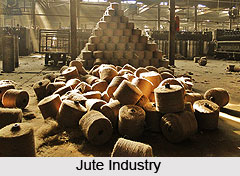 The opening years of the 18th century saw the beginning of protective legislation in England against the import of the Indian goods. This was followed by the prohibition of their wear and use in 1720. However, later on the Company established a permanent market in India for British woollens, metals, stores and provisions. They also prohibited manufacturing of silk fabrics in Bengal. The gradual consolidation of British power in India saw a complete revolution in the commercial relations between England and India. The balance of trade turned against India.
The opening years of the 18th century saw the beginning of protective legislation in England against the import of the Indian goods. This was followed by the prohibition of their wear and use in 1720. However, later on the Company established a permanent market in India for British woollens, metals, stores and provisions. They also prohibited manufacturing of silk fabrics in Bengal. The gradual consolidation of British power in India saw a complete revolution in the commercial relations between England and India. The balance of trade turned against India.
Industry weaving was crushed as a result of the imposition of British tariffs. Indians began to lean more on agriculture. Further laws were passed which ruined the Indian mercantile. India transformed from an industrial country to a raw material producing countries of the world. There was no attempt to reform the land policy or increase agricultural wealth. Unemployment and poverty became exceptional in the history of any modern civilised country. Aristocracy in India did not give wealth for productive enterprises. There was further a wide gulf between the intellectual class and the artisans. The industries were not encouraged to develop by the policy of free trade adopted by England in the nineteenth century. Introduction of railways and wrong exchange-policy further ruined the industries and agriculture.
This state of affairs never lasted long. The rise of the middle classes in India after the introduction of Western education led to the realisation of the need for industrialisation. Private initiative notably by the Tata took a hand in the development of factories specially cotton, iron and steel while the British started plantation industries like those of tea, coffee and indigo. But the state continued to be indifferent or sometimes hostile, as for instance, when the duties on Indian goods were also levied together with those on British goods at the demand of the Indians.
Evolution of Indian Economy
Industries arose in India after the mutiny of 1857. Increasing knowledge, establishment of peace and order, improvements in transport induced the Indians also to invest in the Indian enterprises. Further the Crimean war and the American Civil War stimulated the rise of the jute and cotton industries because the Russian hemp and the American cotton were not available to England.
 The gradual growth of these industries stimulated directly or indirectly the rise of other industries, like engineering, workshops, iron foundries, subsidiary cotton and jute industries and woollen mills. British investments operated in India; foreign banks started working and by 1913 they controlled over three-fourths of the total of bank deposits. The Government helped more the British than the people in India. All these led to hindrance in India`s industrial development and increase her poverty.
The gradual growth of these industries stimulated directly or indirectly the rise of other industries, like engineering, workshops, iron foundries, subsidiary cotton and jute industries and woollen mills. British investments operated in India; foreign banks started working and by 1913 they controlled over three-fourths of the total of bank deposits. The Government helped more the British than the people in India. All these led to hindrance in India`s industrial development and increase her poverty.
The two world-wars forced the British government to revise their economic policy and ultimately grant freedom to India. India remains a land of missed opportunities. In case of agriculture also the case was similar. Before the British came Indian villages had enjoyed some prosperity. There was an agricultural crisis. There was over-crowding and under-development at the same time. There was stagnation with low yields, waste of labour, fragmentation of holdings, sub-division of the fields, multiplication of sub-letting, absentee landlordism or rack-renting, increasing indebtedness and increase in the land-less proletariat.
In the post-Mutiny period the most important development in connection with the fiscal policy of the country is the establishment of free trade. Economically India had become just suppliers of anything and everything but the makers of none. The evils connected with capitalism have been intensified India`s economic troubles are a legacy of the past.
In India during the age of the Pallavas, Pandyas, Cholas and Cheras there were small organisations and centres. In the Gupta age culture was organised more around the capital city than outside and this also preserved the principle of concentration which is the ethos of small independent centres at the cost of dwarfing the provincial life or of the town and the village. Economically also there were organised groups or guilds which looked after material and ethical welfare.



















